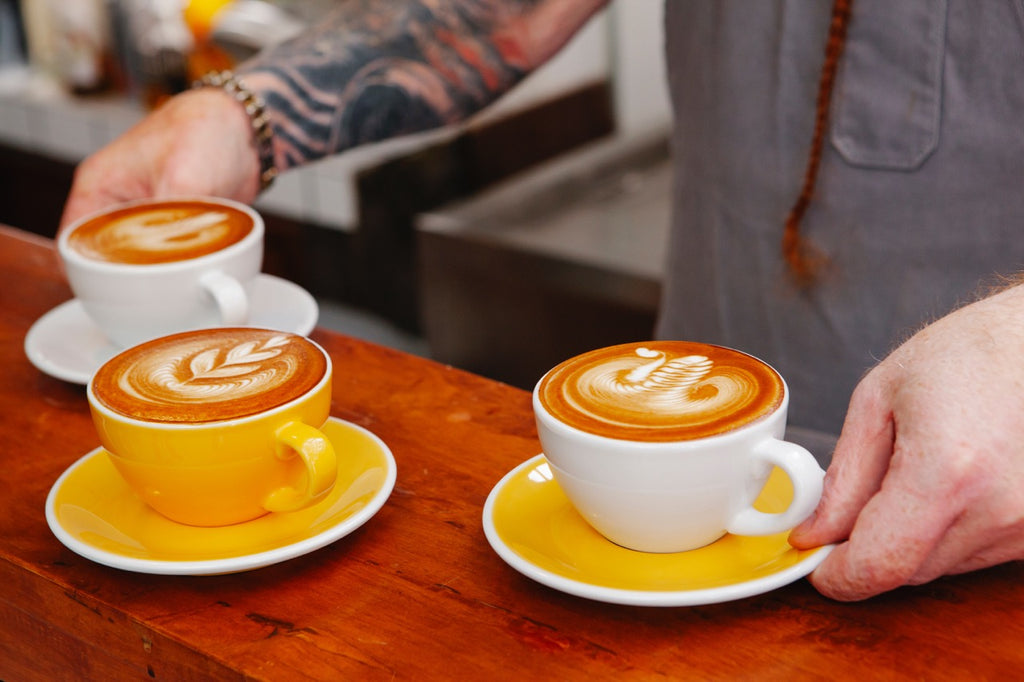
Behind that beautifully poured design on top of your latte, there's a whole lot of physics and chemistry going on. By mastering a range of techniques, ranging from milk steaming to pouring, baristas hone their skills and equip themselves to make excellent latte art time and time again.
Let’s take a look at the fundamentals of latte art, the techniques involved, and a couple of tips to help you become the best latte artist you can be. Read on to learn more.

Milk steaming basics
Steaming milk properly is key to being able to pour great latte art. In most cases, you’ll want to use a steam wand to heat and add steam to the milk, and create beautifully textured milk foam.
Jennifer Yeatts is our Director of Coffee here at Higher Grounds Trading Co. She says that all great latte art designs start with getting the right texture.
“Focus on getting great milk texture first, because if your milk isn't the right pourable texture, you won't get good art,” she explains. “You want the consistency of wet paint or melted ice cream, [with] very few or no discernible bubbles.”
Distance is important, too. If your steam wand is too close to the surface of the milk for too long, you’ll get milk foam with bigger bubbles that are harder to pour. Conversely, submerging the steam wand for the entire time won’t aerate the milk properly, resulting in hot milk instead of milk foam.
The best method for steaming milk is a combination of the two. Firstly, aerate the milk for a couple of seconds to introduce air bubbles, then quickly submerge the steam wand for the remainder of the process.

Milk foam stability and temperature
A big part of creating latte art is maximizing the stability of your milk foam. It needs to be stable enough to hold the design, but not too rigid that the design becomes distorted.
Getting perfect milk foam means balancing three key things: milk proteins, fat content, and temperature.
Each kind of milk has different levels of protein and fat, which affect its stability at different temperatures.
The proteins in milk help to stabilize the milk foam. As you steam milk, proteins envelop the air bubbles, forming the foam and giving it its structure.
Steamed whole milk creates a thick, creamy foam, while skim milk creates a thinner foam with larger bubbles. However, if you overheat your milk, its proteins may break down (known in chemistry as denaturing) and ruin your foam.
Fat content, on the other hand, destabilizes the foam and creates richer flavors. Whole milk has higher fat content (3.5% fat) compared to skim milk (<.5% fat). The more fat, the less air the milk will hold.
Higher milk fat content leads to rich, smooth foam, while milks with lower fat content (like skim milk) will produce a stable, stiffer foam. However, stiff foam won’t pour smoothly, and tend to plop into the cup in one messy blob.
The ideal milk steaming temperature
The ideal temperature for steaming your milk depends on which kind of milk you’re using. Generally speaking, latte art doesn’t require really hot milk, as going too high will cause your foam to disintegrate.
For dairy milk, you generally should steam until 140 to 150°F. Beyond that, the milk will become too firm and aerated. Higher than 160°F, and the milk will burn or curdle.
For alternative milks, the ideal temperature ranges from 130 to 160°F but this varies. Check online or ask a local barista if you’re trying a new type of plant milk.

Latte art pouring techniques
Once you’ve got that silky smooth milk foam down, you’re ready to create some latte art.
Each design requires different techniques, but there are three main pouring factors to remember no matter the design: pour speed, the height of the pour, and the position of the pitcher spout.
Pour speed
Different pour speeds help to achieve unique design elements. You’re going to want to start with a slow, circular pour to create a solid base for your design without disturbing the crema.
Once you’ve got your base, increase your pour speed to create your design. A slower pour will make thicker strokes, while a quicker pour creates thinner strokes.
Pour height
Getting the right distance between your milk pitcher and the cup helps to create an accurate, distinctive design. If you pour from too far away, your milk will just mix in with the espresso, rather than sitting on top of it.
Start your pour with your pitcher a few inches away from the cup to mix the milk and espresso. Then, when you’re ready to begin your design, tilt your cup at a 45° angle, allowing you to keep your pitcher as close to the surface of the liquid as possible.
When you pour low and close to the surface, your designs will be distinct and should float on the surface of the milk-espresso base.
Pitcher spout position
The position of your pitcher’s spout over the cup will determine where your design will end up. It’s helpful to visually split your cup into three horizontal sections: above center, center, and below center.
The tip of your spout will correlate with the top of your design. We recommend not pouring a design with your pitcher’s spout anywhere beyond the center of the cup. This will help keep your art centered and leave your base undisturbed.
Let’s put all the basics for latte art creation together:
- Tilt your cup at a 45-degree angle.
- Start your pour high and slow, then drop the pour lower and closer to the surface to start designing.
- Level out the tilt of the cup as you finish off your design.

Latte art tips for home and professional baristas
Once you’ve got some good milk that’s ready to go, don’t wait too long to start pouring your design. The milk will begin to destabilize and separate the longer it sits on the bar.
Jennifer also recommends starting simple and practicing a lot. She says this can be key to getting more comfortable and confident with your latte art.
“Start simple,” she suggests. “Pour a hundred monk's heads or hearts consistently before you jump to anything more complicated. Get that muscle memory down, then explore more complex multi-step techniques and designs.”
Beyond that, keep in mind that smaller cups will give you less space and time to complete your design. It might be easier to start off with larger cups, as they give you more room for error.
Last, and certainly not least, purge your steam wand after every use. Milk will build up inside, and that’s something nobody wants.
“Nobody wants dry, crusty old milk in their drink,” says Jennifer. “And a clogged steam wand will affect the steam pressure, as well.”

Latte art is an important skill for any barista, and a few key abilities – and plenty of practice – will mean you’re pouring like a pro in no time at all.
If you want to learn more about latte art, click here for more info on our barista training. We tailor courses to attendees and can cover a range of topics, from espresso and coffee fundamentals to more complex skills that you might need behind the bar.
